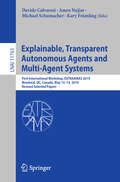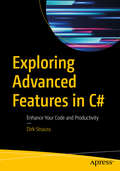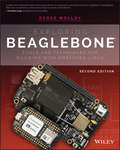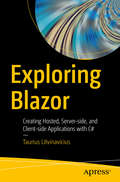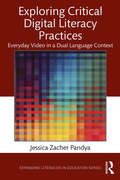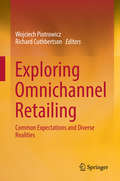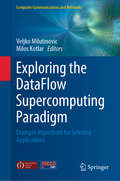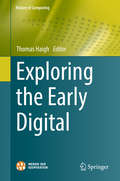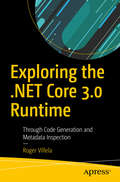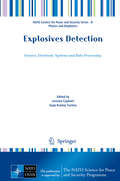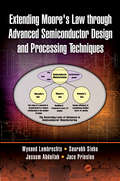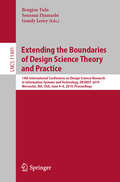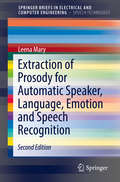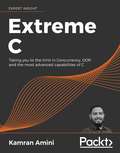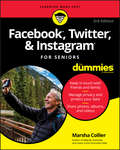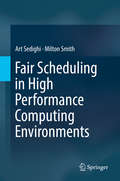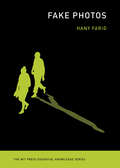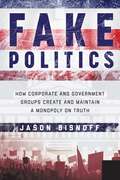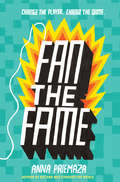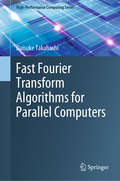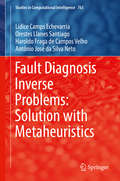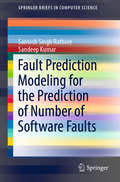- Table View
- List View
Explainable, Transparent Autonomous Agents and Multi-Agent Systems: First International Workshop, EXTRAAMAS 2019, Montreal, QC, Canada, May 13–14, 2019, Revised Selected Papers (Lecture Notes in Computer Science #11763)
by Davide Calvaresi Amro Najjar Michael Schumacher Kary FrämlingThis book constitutes the proceedings of the First International Workshop on Explainable, Transparent Autonomous Agents and Multi-Agent Systems, EXTRAAMAS 2019, held in Montreal, Canada, in May 2019. The 12 revised and extended papers presented were carefully selected from 23 submissions. They are organized in topical sections on explanation and transparency; explainable robots; opening the black box; explainable agent simulations; planning and argumentation; explainable AI and cognitive science.
Exploring Advanced Features in C#: Enhance Your Code and Productivity
by Dirk StraussBecome a more productive programmer by leveraging the newest features available to you in C#. This book highlights the new language features available to you and how to use these and other tools such as Bootstrap, SCSS, and jQuery to enhance your web applications.Exploring Advanced Features in C# starts with some of the new features of C# 7 such as how to implement local functions, tuples and generalized async return types. The book also looks at C# 8, where the author demonstrates how to implement nullable reference types, recursive patterns, ranges, indicies, switch expressions, and many more. Next, you go through some of the distinct features of C# that might often be overlooked such as generics, asynchronous programming, and dynamic types. The author demonstrates how to implement these features through clear and concise examples. Next, you’ll discuss creating responsive web applications using ASP.NET Model View Controller (MVC) where you’ll learn how to combine Bootstrap with jQuery and SCSS to create interactive web applications with a great-looking, user-friendly UI. Moving forward, you will create and run applications on the latest .NET Core version 3.0 as well as explore some of the features of .NET Core 3.0. Finally, you will go through the tips and tricks of Visual Studio 2019 that make you more productive.After reading the book, you will be able to implement new features available in C# and learn how to enhance your application development using ASP.NET MVC and .NET Core.What You Will LearnImplement the new features available in C# 7Enhance your web applications using ASP.NET MVC, Bootstrap, SCSS, and jQuery See what C# 8 has to offer with clear code examples Create and run applications in .NET Core 3.0Who This Is Book ForC# programmers who have worked with C# for a number of years and who want to keep up to date with the latest advancements of the language .
Exploring BeagleBone: Tools and Techniques for Building with Embedded Linux
by Derek MolloyIn-depth instruction and practical techniques for building with the BeagleBone embedded Linux platform Exploring BeagleBone is a hands-on guide to bringing gadgets, gizmos, and robots to life using the popular BeagleBone embedded Linux platform. Comprehensive content and deep detail provide more than just a BeagleBone instruction manual-you'll also learn the underlying engineering techniques that will allow you to create your own projects. The book begins with a foundational primer on essential skills, and then gradually moves into communication, control, and advanced applications using C/C++, allowing you to learn at your own pace. In addition, the book's companion website features instructional videos, source code, discussion forums, and more, to ensure that you have everything you need. The BeagleBone's small size, high performance, low cost, and extreme adaptability have made it a favorite development platform, and the Linux software base allows for complex yet flexible functionality. The BeagleBone has applications in smart buildings, robot control, environmental sensing, to name a few; and, expansion boards and peripherals dramatically increase the possibilities. Exploring BeagleBone provides a reader-friendly guide to the device, including a crash course in computer engineering. While following step by step, you can: Get up to speed on embedded Linux, electronics, and programming Master interfacing electronic circuits, buses and modules, with practical examples Explore the Internet-connected BeagleBone and the BeagleBone with a display Apply the BeagleBone to sensing applications, including video and sound Explore the BeagleBone's Programmable Real-Time Controllers Updated to cover the latest Beagle boards, Linux kernel versions, and Linux software releases. Includes new content on Linux kernel development, the Linux Remote Processor Framework, CAN bus, IoT frameworks, and much more! Hands-on learning helps ensure that your new skills stay with you, allowing you to design with electronics, modules, or peripherals even beyond the BeagleBone. Insightful guidance and online peer support help you transition from beginner to expert as you master the techniques presented in Exploring BeagleBone, the practical handbook for the popular computing platform.
Exploring Blazor: Creating Hosted, Server-side, and Client-side Applications with C#
by Taurius LitvinaviciusBuild and develop web applications with Blazor in C#. This book will cover all three types of Blazor – server-side, client-side, and hosted along with other features of the technology. You’ll see that Blazor is a web UI framework based on C#, Razor, and HTML and how it runs front-end logic using C# either on the server or on the browser using WebAssembly. The author starts by introducing WebAssembly and gives an overview of Blazor along with its various categories. Next, you’ll get started with Blazor where you learn the basics, including Razor syntax implementation. Here you will go over the major differences between Blazor and Razor and how the syntax works. A demo of the layout and navigation for server-side Blazor is followed by usage of Razor syntax to control an application in client-side Blazor. Further, you will go through the project layout, navigation, and routes for the API. Here, you will understand how to access the API from the front end and use the shared library for different models.Moving forward, you will discover how Blazor works with storage, files, and JavaScript. Finally, you will create web applications in Blazor using practical implementations and real-life scenarios for server-side, client-side, and hosted applications. After reading this book you will be able to build web applications with Blazor in C# and .NET Core 3.0. What You Will Learn Bind one-way and two-way data Combine Blazor and JavaScript Understand layout in server-side and client-side applications Execute the general syntax in Razor Who This Book Is For C# and .NET Core developers
Exploring Critical Digital Literacy Practices: Everyday Video in a Dual Language Context (Expanding Literacies in Education)
by Jessica Zacher PandyaIn this book, Jessica Zacher Pandya examines the everyday videomaking practices of students in a dual language, under-resourced school in order to explore the ways children interrogate their worlds, the kinds of identities they craft, and the language and literacy learning practices that emerge from digital video production. Focusing on vulnerable populations who are often left out of innovative in- and out-of-school digital media projects—including English language learners, immigrants, and children with special needs—this book offers an expanded understanding of children’s critical digital literacy practices, and shows how videomaking in the regular curriculum affords opportunities for redistributive social justice. Weaving together pedagogical, methodological, social, and political concerns into her examination of a real-world context, Pandya offers a practical and informative analysis of making videos in schools; examines the impact of videomaking on students’ language use and agency; and adds significantly to current theorizations of digital and new literacies.
Exploring Omnichannel Retailing: Common Expectations and Diverse Realities
by Richard Cuthbertson Wojciech PiotrowiczThis book compiles the current state of knowledge on omnichannel retailing, a new concept in which all sales and interaction channels are considered together, and which aims to deliver a seamless customer experience regardless of the channel. It highlights case studies and examples related to each of the many barriers to an omnichannel approach, demonstrating not just success stories, but also failures. While omnichannel has already been recognized as an emerging retail trend, the articles in this book fill an important gap in research on the topic. Providing readers with essential insights on the omnichannel strategy and its implementation, the book will also stimulate academic discussion on this emerging trend.
Exploring the DataFlow Supercomputing Paradigm: Example Algorithms for Selected Applications (Computer Communications and Networks)
by Veljko Milutinovic Milos KotlarThis useful text/reference describes the implementation of a varied selection of algorithms in the DataFlow paradigm, highlighting the exciting potential of DataFlow computing for applications in such areas as image understanding, biomedicine, physics simulation, and business.The mapping of additional algorithms onto the DataFlow architecture is also covered in the following Springer titles from the same team: DataFlow Supercomputing Essentials: Research, Development and Education, DataFlow Supercomputing Essentials: Algorithms, Applications and Implementations, and Guide to DataFlow Supercomputing.Topics and Features: introduces a novel method of graph partitioning for large graphs involving the construction of a skeleton graph; describes a cloud-supported web-based integrated development environment that can develop and run programs without DataFlow hardware owned by the user; showcases a new approach for the calculation of the extrema of functions in one dimension, by implementing the Golden Section Search algorithm; reviews algorithms for a DataFlow architecture that uses matrices and vectors as the underlying data structure; presents an algorithm for spherical code design, based on the variable repulsion force method; discusses the implementation of a face recognition application, using the DataFlow paradigm; proposes a method for region of interest-based image segmentation of mammogram images on high-performance reconfigurable DataFlow computers; surveys a diverse range of DataFlow applications in physics simulations, and investigates a DataFlow implementation of a Bitcoin mining algorithm.This unique volume will prove a valuable reference for researchers and programmers of DataFlow computing, and supercomputing in general. Graduate and advanced undergraduate students will also find that the book serves as an ideal supplementary text for courses on Data Mining, Microprocessor Systems, and VLSI Systems.
Exploring the Early Digital (History of Computing)
by Thomas HaighChanges in the present challenge us to reinterpret the past, but historians have not yet come to grips with the convergence of computing, media, and communications technology. Today these things are inextricably intertwined, in technologies such as the smartphone and internet, in convergent industries, and in social practices. Yet they remain three distinct historical subfields, tilled by different groups of scholars using different tools. We often call this conglomeration “the digital,” recognizing its deep connection to the technology of digital computing. Unfortunately, interdisciplinary studies of digital practices, digital methods, or digital humanities have rarely been informed by deep engagement with the history of computing.Contributors to this volume have come together to reexamine an apparently familiar era in the history of computing through new lenses, exploring early digital computing and engineering practice as digital phenomena rather than as engines of mathematics and logic. Most focus on the period 1945 to 1960, the era in which the first electronic digital computers were created and the computer industry began to develop. Because digitality is first and foremost a way of reading objects and encoding information within them, we are foregrounding topics that have until now been viewed as peripheral in the history of computing: betting odds calculators, card file systems, program and data storage, programmable calculators, and digital circuit design practices. Reconceptualizing the “history of computing” as study of the “early digital” decenters the stored program computer, repositioning it as one of many digital technologies.
Exploring the .NET Core 3.0 Runtime: Through Code Generation and Metadata Inspection
by Roger VillelaExplore advanced .NET APIs and create a basic .NET core library with dynamic code generation and metadata inspection to be used by other libraries or client applications. This book starts with the benefits of .NET including its fundamental tasks and tools where you will learn .NET SDK tools and the ILDasm tool. This is followed by a detailed discussion on code generation in .NET API programming. Along the way, you will learn how to build a programming model through a code-generator tool and metadata inspector tool using .NET version information for .NET assembly and binary code. Exploring the .NET Core 3.0 Runtime covers the features of Microsoft Visual Studio 2019 using a tutorial and shows you how to create a .NET Core 3.0 application. Here you will configure and deploy your .NET projects along with meta packages and see some do's and don'ts. Finally, you will compare the features of .NET Core 3.0 with the .NET Framework library and its GUI frameworks. After reading this book, you will be able to work in a .NET 3.0 environment and program for its two advanced features: code generation and metadata inspection. What You Will LearnUnderstand the inner workings of an assembly’s structural organizationWork with reflection through the .NET Core platformCarry out dynamic code generation using the .NET Core API's code document model (CodeDOM) Use the metadata mechanism of the .NET Core platformWho This Book Is ForSoftware developers and engineers using .NET and/or the .NET Core platform and tools.
Explosives Detection: Sensors, Electronic Systems and Data Processing (NATO Science for Peace and Security Series B: Physics and Biophysics)
by Lorenzo Capineri Eyüp Kuntay TurmuşThis volume presents selected contributions from the “Advanced Research Workshop on Explosives Detection” hosted by the Department of Information Engineering of the University of Florence, Italy in 2018. The main goal of the workshop was to find out how Science for Peace and Security projects in the field of Explosives Detection contribute to the development and/or refinement of scientific and technical knowledge and competencies. The findings of the workshop, presented in the last section of the book, determine future actions and direction of the SPS Programme in the field of explosives detection and management.The NATO Science for Peace and Security (SPS) Programme, promotes dialogue and practical cooperation between NATO member states and partner nations based on scientific research, technological innovation and knowledge exchange. Several initiatives were launched in the field of explosive detection and clearance, as part of NATO’s enhanced role in the international fight against terrorism. Experts and scientists from NATO members and partner countries have been brought together in multi-year projects, within the framework of the SPS Programme, to cooperate in the scientific research in explosive detection field, developing new technologies and methods to be implemented in order to detect explosive substances in different contexts.
Extending Moore's Law through Advanced Semiconductor Design and Processing Techniques
by Jassem Abdallah Wynand Lambrechts Saurabh Sinha Jaco PrinslooThis book provides a methodological understanding of the theoretical and technical limitations to the longevity of Moore’s law. The book presents research on factors that have significant impact on the future of Moore’s law and those factors believed to sustain the trend of the last five decades. Research findings show that boundaries of Moore’s law primarily include physical restrictions of scaling electronic components to levels beyond that of ordinary manufacturing principles and approaching the bounds of physics. The research presented in this book provides essential background and knowledge to grasp the following principles: Traditional and modern photolithography, the primary limiting factor of Moore’s law Innovations in semiconductor manufacturing that makes current generation CMOS processing possible Multi-disciplinary technologies that could drive Moore's law forward significantly Design principles for microelectronic circuits and components that take advantage of technology miniaturization The semiconductor industry economic market trends and technical driving factors The complexity and cost associated with technology scaling have compelled researchers in the disciplines of engineering and physics to optimize previous generation nodes to improve system-on-chip performance. This is especially relevant to participate in the increased attractiveness of the Internet of Things (IoT). This book additionally provides scholarly and practical examples of principles in microelectronic circuit design and layout to mitigate technology limits of previous generation nodes. Readers are encouraged to intellectually apply the knowledge derived from this book to further research and innovation in prolonging Moore’s law and associated principles.
Extending the Boundaries of Design Science Theory and Practice: 14th International Conference on Design Science Research in Information Systems and Technology, DESRIST 2019, Worcester, MA, USA, June 4–6, 2019, Proceedings (Lecture Notes in Computer Science #11491)
by Bengisu Tulu Soussan Djamasbi Gondy LeroyThis book constitutes the thoroughly refereed proceedings of the 14th International Conference on Designing for a Digital and Globalized World, DESRIST 2019, held Worcester, MA, USA, June 2019. The 20 revised full papers included in the volume were carefully reviewed and selected from 54 submissions. They are organized in the following topical sections: Design Science Research Theory and Methodology; Design Science Research Applications in Healthcare; Design Science Research Applications in Data Science; and Design Science Research Applications in Emerging Topics.
Extraction of Prosody for Automatic Speaker, Language, Emotion and Speech Recognition (SpringerBriefs in Speech Technology)
by Leena MaryThis updated book expands upon prosody for recognition applications of speech processing. It includes importance of prosody for speech processing applications; builds on why prosody needs to be incorporated in speech processing applications; and presents methods for extraction and representation of prosody for applications such as speaker recognition, language recognition and speech recognition. The updated book also includes information on the significance of prosody for emotion recognition and various prosody-based approaches for automatic emotion recognition from speech.
Extreme C
by Kamran AminiExtreme C is for C programmers who want to dig deep into the language and its capabilities. It will help you make the most of the low-level control C gives you
Extremist Propaganda in Social Media: A Threat to Homeland Security
by Michael ErbschloeExtremist Propaganda in Social Media: A Threat to Homeland Security presents both an analysis of the impact of propaganda in social media and the rise of extremism in mass society from technological and social perspectives. The book identifies the current phenomenon, what shall be dubbed for purposes of this book "Blisstopian Societies"—characterized in the abiding "ignorance is bliss" principle—whereby a population is complacent and has unquestioning acceptance of a social doctrine without challenge and introspection. In these subcultures, the malleable population self-select social media content, "news," and propaganda delivery mechanisms. By doing so, they expose themselves only to content that motivates, reinforces, and contributes to their isolation, alienation, and self-regulation of the social groups and individuals. In doing this, objective news is dismissed, fake—or news otherwise intended to misinform—reinforces their stereotyped beliefs about society and the world around them. This phenomenon is, unfortunately, not "fake news," but a real threat to which counterterror, intelligence, Homeland Security, law enforcement, the military, and global organizations must be hyper-vigilant of, now and into the foreseeable future. Chapters cite numerous examples from the 2016 political election, the Russia investigation into the Trump Campaign, ISIS, domestic US terrorists, among many other examples of extremist and radicalizing rhetoric. The book illustrates throughout that this contrived and manufactured bliss has fueled the rise and perpetuation of hate crimes, radicalism, and violence in such groups as ISIS, Boko Haram, Neo-Nazis, white separatists, and white supremacists in the United States—in addition to perpetuating ethnic cleansing actions around the world. This dynamic has led to increased political polarization in the United States and abroad, while furthering an unwillingness and inability to both compromise or see others’ perspectives—further fomenting insular populations increasing willing to harm others and do violence. Extremist Propaganda in Social Media relates current Blisstopian practices to real-world hate speech and violence, connecting how such information is consumed by groups and translated into violent action. The book is an invaluable resources for those professionals that require an awareness of social media radicalization including: social media strategists, law enforcement, Homeland Security professionals, military planners and operatives—anyone tasked with countering combat such violent factions and fringes in conflict situations.
Facebook, Twitter, and Instagram For Seniors For Dummies
by Marsha CollierEnjoy the top social media sites with ease and security Done correctly, social media is a way to connect friends, family, and the world while still maintaining security and privacy. Facebook, Twitter, & Instagram For Seniors For Dummies, 3rd Edition offers advice on how to enjoy the three most popular social media options while avoiding worry about who sees what you share. Written by social media expert Marsha Collier, this book walks you through establishing accounts, making connections, and sharing content including photos and video. You learn the settings to adjust on each platform to maintain privacy and filter out the content you don't want. This book also explains the subtle art of avoiding or blocking people on social platforms without jeopardizing your real-world relationships! Take control of what you share Connect with others Take and share your best pictures Use social media as a news source Social media sites are great fun once you learn how to cut through the clutter—and this book shows you how!
Fair Scheduling in High Performance Computing Environments
by Art Sedighi Milton SmithThis book introduces a new scheduler to fairly and efficiently distribute system resources to many users of varying usage patterns compete for them in large shared computing environments. The Rawlsian Fair scheduler developed for this effort is shown to boost performance while reducing delay in high performance computing workloads of certain types including the following four types examined in this book: i. Class A – similar but complementary workloads ii. Class B – similar but steady vs intermittent workloads iii. Class C – Large vs small workloads iv. Class D – Large vs noise-like workloads This new scheduler achieves short-term fairness for small timescale demanding rapid response to varying workloads and usage profiles. Rawlsian Fair scheduler is shown to consistently benefit workload Classes C and D while it only benefits Classes A and B workloads where they become disproportionate as the number of users increases. A simulation framework, dSim, simulates the new Rawlsian Fair scheduling mechanism. The dSim helps achieve instantaneous fairness in High Performance Computing environments, effective utilization of computing resources, and user satisfaction through the Rawlsian Fair scheduler.
Fake Photos (The MIT Press Essential Knowledge Series)
by Hany FaridA concise and accessible guide to techniques for detecting doctored and fake images in photographs and digital media. Stalin, Mao, Hitler, Mussolini, and other dictators routinely doctored photographs so that the images aligned with their messages. They erased people who were there, added people who were not, and manipulated backgrounds. They knew if they changed the visual record, they could change history. Once, altering images required hours in the darkroom; today, it can be done with a keyboard and mouse. Because photographs are so easily faked, fake photos are everywhere—supermarket tabloids, fashion magazines, political ads, and social media. How can we tell if an image is real or false? In this volume in the MIT Press Essential Knowledge series, Hany Farid offers a concise and accessible guide to techniques for detecting doctored and fake images in photographs and digital media. Farid, an expert in photo forensics, has spent two decades developing techniques for authenticating digital images. These techniques model the entire image-creation process in order to find the digital disruption introduced by manipulation of the image. Each section of the book describes a different technique for analyzing an image, beginning with those requiring minimal technical expertise and advancing to those at intermediate and higher levels. There are techniques for, among other things, reverse image searches, metadata analysis, finding image imperfections introduced by JPEG compression, image cloning, tracing pixel patterns, and detecting images that are computer generated. In each section, Farid describes the techniques, explains when they should be applied, and offers examples of image analysis.
Fake Politics: How Corporate and Government Groups Create and Maintain a Monopoly on Truth
by Jason BisnoffIn “grassroots” campaigns, the grass isn’t always green—or natural.In today’s chaotic world, where the multiplication of information sources creates competing narratives, credibility is the key to winning the war of ideas. This is the reason why governments and corporations resort to astroturfing—creation of ostensibly grassroots movements set up to advance political agendas and commercial campaigns. The democratization of information and polarization of politics offer a perfect storm.Fake Politics tells the stories of how this practice has transformed political activism into a veiled lobbying effort by the rich and the powerful. Through a series of vignettes involving the tea party, oil industry, big tobacco, big data, and news media, this book will explore the similarities and differences between various campaigns that appeared as grassroots but, in reality, were lobbying efforts fueled by governments, corporations, major industries, and religious institutions.The process, named for the artificial grass fields at football stadiums and high schools across the country, became so prevalent in the last two decades that it now sits at a tipping point. In the era of “fake news” and “alternative facts,” with the truth well on its way to becoming indistinguishable from fabrication, what can the past of astroturfing tell us about the future of grassroots activism?
Fan the Fame
by Anna PriemazaSometimes before you can build something up, you have to burn it down. <P><P>Fans of Rainbow Rowell’s Fangirl and Jennifer Mathieu’s Moxie will fall in love with this fiercely crafted YA novel about followers, fame, and fighting for what’s right. <P><P>Lainey wouldn’t mind lugging a camera around a video game convention for her mega-famous brother, aka YouTube streamer Codemeister, except for one big problem. He’s funny and charming online, but behind closed doors, Cody is a sexist jerk. <P><P>SamTheBrave came to this year’s con with one mission: meeting Codemeister—because getting his idol’s attention could be the big break Sam needs. <P><P>ShadowWillow is already a successful streamer. But when her fans start shipping her with Code, Shadow concocts a plan to turn the rumors to her advantage. <P><P>The three teens’ paths collide when Lainey records one of Cody’s hateful rants on video and decides to spill the truth to her brother’s fans—even if that means putting Sam and Shadow in the crosshairs. <P><P>Told through three relatable voices, this contemporary YA novel from the author of the widely praised Kat and Meg Conquer the World skillfully balances feminism, accountability, and doing the right thing—even when it hurts.
Las fantásticas luciérnagas
by Oscar S. ArandaOscar S. Aranda desvela los secretos que se esconden tras la luz de las luciérnagas. A través de los recuerdos, el autor de El lenguaje secreto de la naturaleza nos invita a descubrir el luminoso sistema de comunicación de las luciérnagas. Unos insectos que frecuentemente se han comparado con las hadas y que se han visto obligados a adaptarse de formas sorprendentes a la contaminación lumínica actual.
Farb- und Formpsychologie
by Tobias C. BreinerDieses Werk ist eine umfassende und praxisrelevante Darstellung zur Farb- und Formpsychologie. Mit einer klaren Sprache und über 100 farbigen Abbildungen wird Ihnen die komplexe Thematik auf eine wissenschaftliche und anregende Art veranschaulicht.Über eine allgemeine Einführung in die Grundlagen des visuellen Systems hinaus werden Sie ebenfalls spezielles Wissen zu Assoziationen, Wirkungen und Anwendungen bestimmter Farben und Formen erwerben. Speziellen Wert legt der Autor dabei auf deren Einsatz im Game Design. Es wird zudem erstmals eine neue Farbstudie präsentiert, die zeigt, dass die Assoziationen zu Farben sich in einem in sich logischen dreidimensionalen System anordnen lassen. Die daraus gezogenen überraschenden Erkenntnisse liefern mögliche Antworten auf fundamentale Fragen der Philosophie. Das Buch ist daher nicht nur ein Muss für Wahrnehmungspsychologen und Designer, sondern eine Bereicherung für alle an dieser Thematik Interessierten.
Fast Fourier Transform Algorithms for Parallel Computers (High-Performance Computing Series #2)
by Daisuke TakahashiFollowing an introduction to the basis of the fast Fourier transform (FFT), this book focuses on the implementation details on FFT for parallel computers. FFT is an efficient implementation of the discrete Fourier transform (DFT), and is widely used for many applications in engineering, science, and mathematics. Presenting many algorithms in pseudo-code and a complexity analysis, this book offers a valuable reference guide for graduate students, engineers, and scientists in the field who wish to apply FFT to large-scale problems.Parallel computation is becoming indispensable in solving the large-scale problems increasingly arising in a wide range of applications. The performance of parallel supercomputers is steadily improving, and it is expected that a massively parallel system with hundreds of thousands of compute nodes equipped with multi-core processors and accelerators will be available in the near future. Accordingly, the book also provides up-to-date computational techniques relevant to the FFT in state-of-the-art parallel computers. Following the introductory chapter, Chapter 2 introduces readers to the DFT and the basic idea of the FFT. Chapter 3 explains mixed-radix FFT algorithms, while Chapter 4 describes split-radix FFT algorithms. Chapter 5 explains multi-dimensional FFT algorithms, Chapter 6 presents high-performance FFT algorithms, and Chapter 7 addresses parallel FFT algorithms for shared-memory parallel computers. In closing, Chapter 8 describes parallel FFT algorithms for distributed-memory parallel computers.
Fault Diagnosis Inverse Problems: Solution with Metaheuristics (Studies in Computational Intelligence #763)
by Lídice Camps Echevarría Orestes Llanes Santiago Haroldo Fraga Campos Velho Antônio José Silva NetoThis book presents a methodology based on inverse problems for use in solutions for fault diagnosis in control systems, combining tools from mathematics, physics, computational and mathematical modeling, optimization and computational intelligence. This methodology, known as fault diagnosis – inverse problem methodology or FD-IPM, unifies the results of several years of work of the authors in the fields of fault detection and isolation (FDI), inverse problems and optimization. The book clearly and systematically presents the main ideas, concepts and results obtained in recent years. By formulating fault diagnosis as an inverse problem, and by solving it using metaheuristics, the authors offer researchers and students a fresh, interdisciplinary perspective for problem solving in these fields. Graduate courses in engineering, applied mathematics and computing also benefit from this work.
Fault Prediction Modeling for the Prediction of Number of Software Faults (SpringerBriefs in Computer Science)
by Santosh Singh Rathore Sandeep KumarThis book addresses software faults—a critical issue that not only reduces the quality of software, but also increases their development costs. Various models for predicting the fault-proneness of software systems have been proposed; however, most of them provide inadequate information, limiting their effectiveness. This book focuses on the prediction of number of faults in software modules, and provides readers with essential insights into the generalized architecture, different techniques, and state-of-the art literature. In addition, it covers various software fault datasets and issues that crop up when predicting number of faults. A must-read for readers seeking a “one-stop” source of information on software fault prediction and recent research trends, the book will especially benefit those interested in pursuing research in this area. At the same time, it will provide experienced researchers with a valuable summary of the latest developments.
